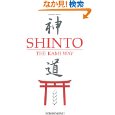‘Shinto: The Kami Way’ by Sokyo Ono US/Japan: Tuttle, 1962 116 pages, small size. ISBN 4-8053-0189-9 $5.00
$5.00
This book has for long been the classic work on Shinto in English. For years it seemed to be the only book on the subject, and it has been in print for an extraordinary length of time. It has the virtue of seeming authoritative, for it was written by a professor of Kokugakuin University who was also a lecturer for Jinja Honcho. As such, it comes close to presenting an orthodox, official version of the religion though in reality there is no such thing. It presents the traditional, conservative view of Shinto as Japan’s indigenous enduring religion which has in recent times recovered the independence it had before the advent of Buddhism. Though occasionally cautious and unclear, it covers itself by claiming that Shinto prefers ambiguity to clarity. Even though the book came out nearly fifty years ago, most of the content has not dated. All the important aspects of the religion are covered, from beliefs and practice to history and political characteristics. The author is concerned to present a balanced view, and while the writing may be bland at times, it is easily read and full of essential information in comprehensible language. Just about all the most commonly asked questions are addressed, and the author gives an admirably detailed overview of the religion as a whole.
Summary: It remains a classic and an essential introduction for anyone interested in Shinto.
******************
For another review, with some revealing points about the contents, see here.

If what Dr. Ono wanted to do was to write an accessible and inoffensive introduction to Shinto for English speakers, he succeeded.
This is a book I would be willing to hand almost anyone who hadn’t heard of Shinto, or was asking the very basic questions. It introduces the most important concepts in ways that are not too complex or too simple, and it is short and easy to read.
It is a little dated. I’m sure some of the numbers of registered shrines are out of date, and have changed. Much of the text seems designed to defuse the propaganda the United States spread about Shinto during World War II, which is not as strongly needed today if it is needed at all.
Regardless, I agree that it’s still a good place to start for many people. I’d rather have them start with this book than with Wikipedia.
Thank you for that… you make good points about the post-WW2 context in which the book was written, yet over 50 years later there are surprisingly few rivals if any for a common sense overview of this kind.